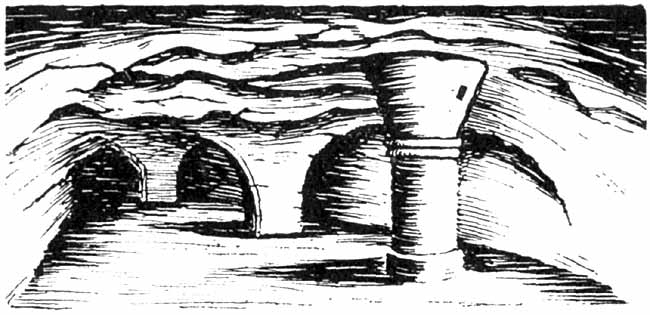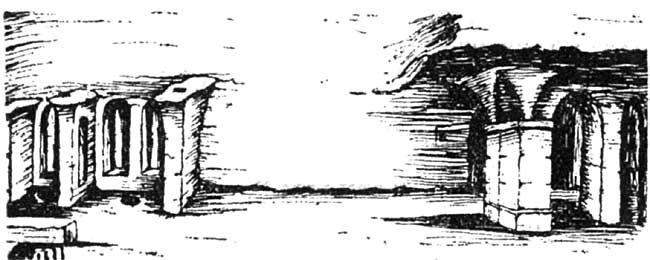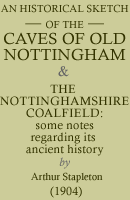An Historical Sketch of the Caves of Old Nottingham and The Nottinghamshire Coalfield: some notes regarding its ancient history by Alfred Stapleton (1904)
To interpret the name of Nottingham as signifying "Town of Caves" is an ancient, and apparently an ineradicable error, arising out of a misreading of the words of Asser. However, the old writers were not nearly so blameworthy herein as in respect to many other stumbling blocks they placed in the paths of posterity. Indeed, it was a frequent hypothesis, in former days, that the cavities below the ground were capable of swallowing up the whole of the town above. In early local deeds and charters relating to town properties it became customary to insert the clause "as well above as below ground," or words to that effect. It is unquestioned that this was, par excellence, the characteristic feature of ancient Nottingham, distinguishing it from all other English towns, and one that might reasonably have been expected to furnish it with a name.
The oldest caves.
The fundamental reason for the universal prevalence of subterranean works in Nottingham is explained by the soft and easily excavated character of the sandstone rock on which the old town wholly stands. This rock terminates southwards in cliff faces, representing the north limit of the Trent valley. The range of natural cliffs extends for two or three miles, divided into the three main sections of the Town Cliff, the Castle Rock, and Sneinton Hermitage, is excavated throughout its entire length, and varies in height from a few feet to 130ft. (We ought to mention that the third-named section has recently been largely cut away, in connection with modern street improvements.) It was probably in these cliff faces that the earliest excavations were scooped, as dwelling-places, by primitive man. Ignorance of inevitable natural laws, as the works were continually extended, resulted in the rook being unduly undermined, and during the eighteenth and nineteenth centuries we have many more or less disastrous records of sudden subsidences and collapses. As the same process must have been going on during many centuries, it is obvious that the original cliff face has receded in many places.

Great Caves. Queen-street, 64ft. by 16ft., destroyed on building General Post Office.
Minor and later cliff faces were produced when Nottingham became a settled place, on either side of the inclined, sunken roads, worn by traffic and rainfall. One of these, mentioned in 1357 as "Hologate," is yet called "Hollow Stone." Here, likewise, primitive dwelling-places were excavated. In comparatively modern times we can trace the suppression of these places, but the date of their origin is beyond our ken.
Their purpose.
It is perhaps superfluous to say that old-time writers and local historians have variantly ascribed the caves of Nottingham, collectively, to all ages and peoples, to secular and religious purposes, &c. On this head we shall take the liberty of ignoring all they say, for if one thing is more patent, than another, it is that, as Mr. W. H. Stevenson remarks, "The inhabitants of Nottingham have at all periods taken advantage of the soft nature of the Bunter sandstone upon which it stands for the purpose of excavation.'' Indeed, we have record of the process going on down to modern time, while we are equally sure that the excavations were put to a varietv of uses. There is no need for, nor logic in, ascribing them all to one age and one purpose.
Akin to such theories are the wonderful stories—as if the "rock-holes" were not sufficiently wonderful without wild exaggeration—of underground passages leading from the heart of the town to the Castle, or to the Forest, from the Castle to Lenton, &c., &c.
But the subject of the Nottingham caves is a vast one, such as is not capable of being epitomised other than in a large volume. Strangely, however, though an extensive fugitive literature, of a kind, has gathered around it, there is no standard work of reference, nor, indeed, any separate book dealing with the caves. Our present task is by no moans that of supplying the undeniably "long-felt want," but mainly the lighter labour of marshalling the literature or early references, wherein we hope to include all that is important to the historical student, besides much that is curious. Although not as yet susceptible of that precise analysis and exposition that modern research has rendered possible in the case of various other features of the ancient town, there are nevertheless certain facts and data now accessible that may well replace much of the shoddy history hitherto passing current, and that indeed may fairly claim to serve as a foundation, or, at least a starting point, for the accurate study of the subject.
It must be confessed that we are quite ignorant as to the inner life and history of the cave-dwellings, fascinating as such a chronicle would be. The many tragedies that must have been enacted, the countless human beings who must have breathed their last within the rock walls, during many centuries, have left no record behind.
A British town of caves.
(By far the earliest, as well as the most important, note we have, is represented by the words of the Welshman Asser, the friend and biographer of Alfred the Great, who gives to Nottingham; the Welsh name of Tig guocobauc, which, as he correctly informs us, means "the dwelling of caves" ("Scnotengaham, quod Brittanice Tigguocobauc interpretatur, Latine autem 'speluncarum domus'"). It is gratifying, in connection wdth this name, that Mr. W. H. Stevenson, M.A., quotes the high authority of Professor Rhys for the statement that it is a fairly correct Old Welsh form, which would appear in Modern Welsh as ty gogofawg, "cavy house."
Mr. W. H. Stevenson continues: "Considerable doubt has been thrown upon the authenticity of the work ascribed to Asser, but it is now generally admitted that parts of it are genuine. The passage relating to Nottingham is one that is believed to be authentic. According to Asserts wording, this Welsh name of Nottingham seems to be merely a translation of the Old English name Snotinga-ham. This reading is the origin of the oft-repeated' assertion that 'Nottingham' means 'the dwelling of caves.' But there is a fatal objection to this etymology. We are utterly unable to find any trace of the existence of such a word as snoting, a cave, in Old English, or in any of its sister dialects. (The usual Old English word for a cave is scroef, gen. pl. scrafa)." Mr. Stevenson adds that Asser's "speluncarum domus" is intended as a translation of the Old Welsh Tig guocobauc, and not, as the construction of the passage suggests, of the English Scnotenga-ham."
The same scholar remarks that from Asser the passage was copied by Florence of Worcester and Simeon of Durham, and it thus acquired a wide circulation amongst the later chroniclers. Thevisa's translation of Higden's version in his "Polycronicon," the great history book of the fourteenth and fifteenth centuries, is quaint:—"Notyngham stondith uppon Trent, and sometyme heet [= hight] Snotyngham, that is 'the woning [= dwelling] of dennes' [= caves], for the Danes dwellid there sometyme, and were i-loggedf as me telleth, and i-digged dennes and caves under hard rokkes and stones."
DOMESDAY BOOK.
Passing on to Domesday Book, we read that "In the ditch of the borough were seventeen houses, and other six houses." This has reference to the ditch of the old borough, on St. Mary's Hill—a military earthwork then apparently obsolete. Of course, it was cut in the sand rock, and hence, presenting faces, offered further facilities for hewing rock dwellings. Such, apparently, were the 23 houses mentioned in the Domesday Book. Though built over centuries ago, modern excavations have conclusively proved that the sides of the ditch were so utilised, while the discovery of Roman earthenware vessels, with pointed bottoms, lend colour to the suggestion that the earthworks themselves, in their origin, extend back to ancient British times.
As may be inferred from what Asser says, there is no doubt that rock excavations existed in what we now call Nottingham ages before the Norman Conquest. Nevertheless, it may bo as well here to mention that no actual remains of manifestly pre-Norman times are in evidence at the present day. We do not say that no existing excavations is so old, which indeed would be contrary to our belief, but only that abstract architectural or other evidence is lacking. The truth is that the vast majority of the Nottingham caverns are absolutely void of architectural character or embellishment, and are consequently referable to any or all ages. On the other hand, imagining for a moment that Saxon ornamentation had once been sculptured, there are yet various reasons why it should not have survived down to our day. In the first place, the sandrock is so soft and perishable that it is very questionable whether, under the most favourable conditions palpable architectural details could survive so long as a thousand years. In the second place the uninterrupted occupation or utilisation of these places is antagonistic to their preservation. Thirdly, as in the case of buildings, we are not without evidence that there was a tendency to remodel them in accordance with the prevalent architectural style. But most of all we lean to the view that, as purely utilitarian works, ornamentation of a durable type was rarely or never attempted in early times. Surface scratchings, so to speak, would inevitably perish.
Difficulties of access.
As these Nottingham caverns are all situate under, or entered from private properties, no doubt many important examples yet remain unknown, except to owners, who are rarely interested. Vast numbers have been destroyed during modern times, while rebuilding properties on up-to-date lines, with "basements" in place of cellars, for they occur beneath every house in the old town. Where this process goes on, all caverns or rock work in the way are of course removed, and the entrances of lower ranges of excavations, where such exist, are filled in, or walled up. The interval between the laying open of ancient excavations and their destruction or burial is usually very brief. The further difficulties of obtaining a sketch, or even decent materials for a description, by candle light, among heaps of debris, has operated against records being kept, except in a few instances. In short, paradoxical as it may seem, illustrations of Nottingham subterranean dwellings occur in none of our local histories, and indeed very few drawings or photographs are in existence, except in the case of such as present an exterior aspect.

Caves, Queen-street, drawn when partly demolished, 1893.
DANGERS.
Inexperienced or negligent builders occasionally run grave risks in Nottingham through not following the now usual procedure of boring or testing the supposed "solid rock" foundation. In one case (in Albert-street), a pillar helping to support the front of a modern building, rested on the crown or roof of an unsuspected excavation, and subsequently dropped bodily through. A well-known local architect, now deceased, once related to us how. inspecting the foundations of an enormous lace warehouse (in Broadway), he broke into a cold sweat on discovering that in one place the wall rested on only two feet thickness of sandrock separating it from an ancient excavation below, of which the builders had known nothing. Of course a retaining wall was promptly built in the hollow, from floor to roof. Again, the same gentleman told us that, when busy on a well-known establishment in the Market-place (Messrs. Griffen and Spalding's), he was compelled to carry down his foundations much deeper than had been originally intended, for, on the rock being probed, no less than three tiers of excavations were found to exist, one below another. After this experience, he made it a rule never to suffer the building of foundations, on the sandrock of old Nottingham, until he had tested the soundness of the latter to a depth of at least six feet. But it is time we reverted to historical matters.
"PEN-PITS."
In dealing with actual examples of Nottingham rock excavations, we must not overlook a type of unknown antiquity, one that, curiously, appears to have been unrecorded prior to 1896, when a number were laid bare in the course of the Great Central Railway excavations. We refer to certain funnel or bell-shaped holes, which have been tentatively called "pen-pits." If referable to primitive man, these holes could have served admirably as pit-falls for man or wild beast, and as "houses of detention" for either. It happens that the spot where they were most in evidence—the site and vicinity of the Old Town Hall—was in a military sense the weakest point of the town cliff, where in fact it was little more than a steep slope. The suggestion that those actually under the Town Hall may have served as prisons or dungeons in the ordinary sense possibly fails to touch the question of their origin. At least it takes no cognisance of the remainder. But respecting these places we cannot do better than quote their recorder—the late James Shipman, F.G.S.: —
"Probably the oldest of them (the Town Hall caverns)—certainly the most remarkable—was a series of bell-shaped holes made in the highest part of the ground, and within the precincts of the old Town Hall. In fact, two, if not three, were found underneath the building itself, and two others under the prison yard at the back. They were excavated out of the local sandrock, but had been filled up at some time or other, apparently in the latter part of the eighteenth century, judging by the character of the pottery they contained. They were filled with dark soil, coal slack, half-burnt cinders, bits of charcoal, and yellow sand, sometimes in layers. Two more of these curious conical excavations were met with at the corner of Fletcher-gate and Weekday-cross, and about 60ft. back from the roadway, so that they were not confined to the site of the old Town Hall. The two latter, however, I did not see myself. The conical holes that I myself saw were hollowed out of a platform of sandrock eight or ten feet below the level of Weekday-cross.
"The deepest and most conspicuous of them was met with at the north-east angle of the cutting at Weekday-cross, and just at the mouth of the tunnel. This was circular in shape. It was 16ft. 7in. in depth, and 7ft. 6in. in diameter at the bottom, narrowing towards the top to 4ft. The bottom of the hole was not flat, as was the case with the rest of these holes, but was curiously concave, the centre being as much as 15 inches lower than the circumference. The bottom of the hole was two feet above the level of the railway. There were indications that the hole had been rudely arched over with lumps of sandrock, cemented together and covered over with concrete, at some period, probably when the hole was filled up. The old massive stone wall of the cells passed over the eastern edge of it, the hole itself being immediately under the floor of the cell.
"The second cone-shaped cavity was met with on the opposite side of the railway cutting. This hole was not circular, but was nearly square, the sides converging in wards towards the top, so that, although it was 7ft. wide at the bottom, it was only 4ft. 6in. wide at the top, and was 11ft. deep. The bottom was 9ft. above the base of the cutting ... In the circular pit there was no indication as to how it was entered, and no trace whatever of steps; but in this one there were traces of foot-holes on one side at least, the other side having been cut away before the cavity was discovered. The third of those curious cavities was met with at the extreme southern edge of the gaol precincts, on the east side of the cutting, and about 54ft. from the deep, circular pit. It was, in fact, just underneath the back wall of the prison yard. Like the second one described, it was more or less square in shape, but one side was perpendicular, while the other sides overhung. The hole was 10ft. deep and 7ft. at the bottom, narrowing to about 4ft. at the top."
Mr. Shipman then goes on to speak of three other such holes found in the same neighbourhood. Coming to the question of their original purpose, he truthfully says none of our local historians allude to anything like them, concluding:—"I have learnt that in the bell-shaped hole at the north-west corner of the Weekday-cross cutting, about a foot from the bottom, iron shackles for securing the legs of a prisoner were found. Embedded in the side of the hole was an eye-bolt, or staple, with a piece of chain attached, by which the prisoners had been secured. The irons were completely corroded with trust, go much so, in fact, that they were regarded as useless, and not worth preserving, and they were thrown away. This removes all doubt as to what these holes found underneath the old Town Hall were used for. at one time at any rate. At a later period they were probably used as refuse pits, and were finally completely filled up and covered over."
